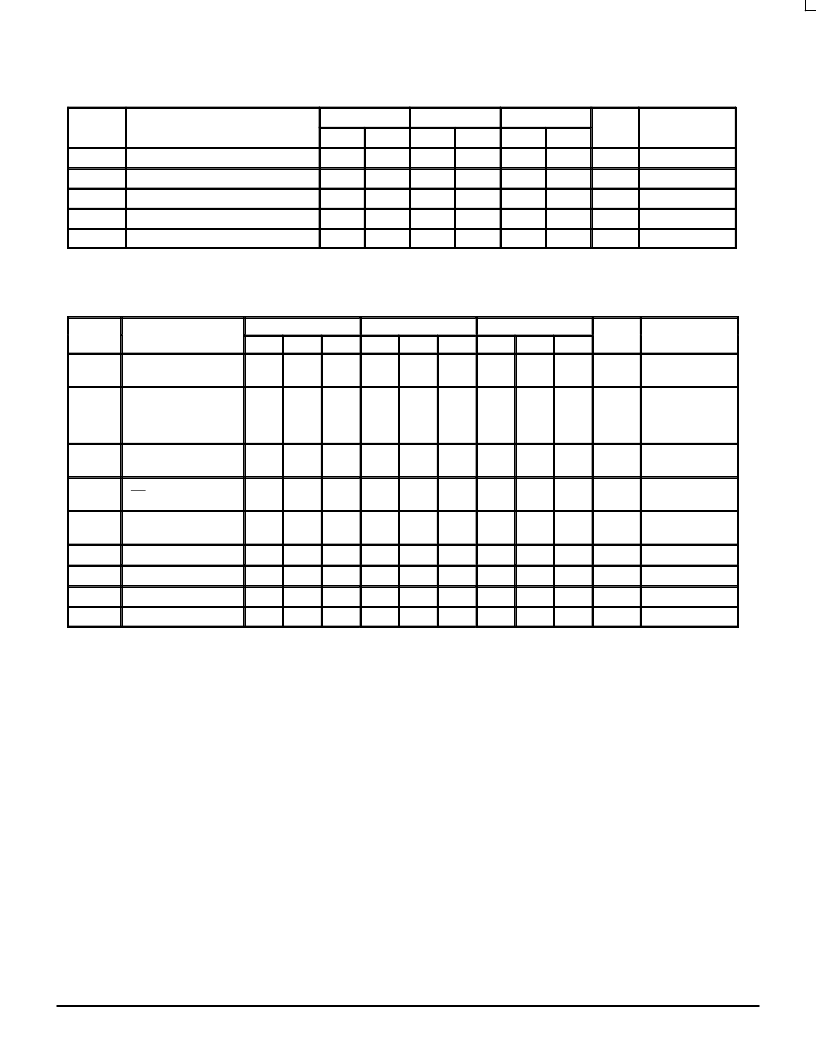- 您現(xiàn)在的位置:買賣IC網(wǎng) > PDF目錄369893 > MC10H641FN (MOTOROLA INC) SINGLE SUPPLY PECL-TTL 1:9 CLOCK DISTRIBUTION CHIP PDF資料下載
參數(shù)資料
| 型號: | MC10H641FN |
| 廠商: | MOTOROLA INC |
| 元件分類: | 時鐘及定時 |
| 英文描述: | SINGLE SUPPLY PECL-TTL 1:9 CLOCK DISTRIBUTION CHIP |
| 中文描述: | 10H SERIES, LOW SKEW CLOCK DRIVER, 9 TRUE OUTPUT(S), 0 INVERTED OUTPUT(S), PQCC28 |
| 封裝: | PLASTIC, LCC-28 |
| 文件頁數(shù): | 3/8頁 |
| 文件大小: | 115K |
| 代理商: | MC10H641FN |

MC10H641 MC100H641
2–3
MOTOROLA
MECL Data
DL122 — Rev 6
100H PECL DC CHARACTERISTICS
0
°
C
25
°
C
85
°
C
Symbol
Characteristic
Min
Max
Min
Max
Min
Max
Unit
Condition
IIH
IIL
VIH
VIL
VBB
1. PECL VIH, VIL, and VBB are referenced to VE and will vary 1:1 with the power supply. The levels shown are for VE = 5.0V.
Input HIGH Curren
225
175
175
μ
A
Input LOW Current
0.5
0.5
0.5
μ
A
Input HIGH Voltage
3.835
4.120
3.835
4.120
3.835
4.120
V
VE = 5.0V
1
VE = 5.0V
1
VE = 5.0V
1
Input LOW Voltage
3.190
3.525
3.190
3.525
3.190
3.525
V
Output Reference Voltage
3.62
3.74
3.62
3.74
3.62
3.74
V
AC CHARACTERISTICS
(VT = VE = 5.0V
±
5%)
TJ = 0
°
C
Typ
TJ = + 25
°
C
Typ
TJ = + 85
°
C
Typ
Symbol
Characteristic
Min
Max
Min
Max
Min
Max
Unit
Condition
CL = 50 pF
1
tPLH
tPHL
Propagation Delay
D to Q
5.00
5.36
5.50
5.86
6.00
6.36
4.86
5.27
5.36
5.77
5.86
6.27
5.08
5.43
5.58
5.93
6.08
6.43
ns
tskew
Device Skew
Part–to–Part
Single VCC
Output–to–Output
1000
750
350
1000
750
350
1000
750
350
ps
CL = 50pF
2
CL = 50 pF
3
CL = 50 pF
4
tPLH
tPHL
Propagation Delay
LEN to Q
4.9
6.9
4.9
6.9
5.0
7.0
ns
CL = 50 pF
tPLH
tPHL
Propagation Delay
EN to Q
5.0
7.0
4.9
6.9
5.0
7.0
ns
CL = 50 pF
tr
tf
Output Rise/Fall
0.8V to 2.0V
1.7
1.6
1.7
1.6
1.7
1.6
ns
CL = 50 pF
fMAX
Max Input Frequency
65
65
65
MHz
CL = 50 pF
5
tREC
Recovery Time EN
1.25
1.25
1.25
ns
tS
Setup Time
0.75
0.50
0.75
0.50
0.75
0.50
ns
tH
Hold Time
0.75
0.50
0.75
0.50
0.75
0.50
ns
1. Propagation delay measurement guaranteed for junction temperatures. Measurements performed at 50MHz input frequency.
2. Skew window guaranteed for a single temperature across a VCC = VT = VE of 4.75V to 5.25V (See Application Note in this datasheet).
3. Skew window guaranteed for a single temperature and single VCC = VT = VE
4. Output–to–output skew is specified for identical transitions through the device.
5. Frequency at which output levels will meet a 0.8V to 2.0V minimum swing.
DETERMINING SKEW FOR A SPECIFIC APPLICATION
The H641 has been designed to meet the needs of very low
skew clock distribution applications. In order to optimize the
device for this application special considerations are
necessary in the determining of the part–to–part skew
specification limits. Older standard logic devices are specified
with relatively slack limits so that the device can be
guaranteed over a wide range of potential environmental
conditions. This range of conditions represented all of the
potential applications in which the device could be used. The
result was a specification limit that in the vast majority of cases
was extremely conservative and thus did not allow for an
optimum system design. For non–critical skew designs this
practice is acceptable, however as the clock speeds of
systems increase overly conservative specification limits can
kill a design.
The following will discuss how users can use the
information provided in this data sheet to tailor a part–to–part
skew specification limit to their application. The skew
determination process may appear somewhat tedious and
time consuming, however if the utmost in performance is
required this procedure is necessary. For applications which
do not require this level of skew performance a generic
part–to–part skew limit of 2.5ns can be used. This limit is good
for the entire ambient temperature range, the guaranteed VCC
(VT, VE) range and the guaranteed operating frequency range.
相關(guān)PDF資料 |
PDF描述 |
|---|---|
| MC10170L | 9+2-Bit Parity Generator/Checker |
| MC10170 | 9+2-Bit Parity Generator/Checker |
| MC10170P | 9+2-Bit Parity Generator/Checker |
| MC10171L | Dual Binary to 1-4 Decoder(Low) |
| MC10171 | Dual Binary to 1-4 Decoder(Low) |
相關(guān)代理商/技術(shù)參數(shù) |
參數(shù)描述 |
|---|---|
| MC10H641FNG | 功能描述:轉(zhuǎn)換 - 電壓電平 5V PECL to TTL 1:9 Clock Driver RoHS:否 制造商:Micrel 類型:CML/LVDS/LVPECL to LVCMOS/LVTTL 傳播延遲時間:1.9 ns 電源電流:14 mA 電源電壓-最大:3.6 V 電源電壓-最小:3 V 最大工作溫度:+ 85 C 安裝風(fēng)格:SMD/SMT 封裝 / 箱體:MLF-8 |
| MC10H641FNR2 | 功能描述:轉(zhuǎn)換 - 電壓電平 5V PECL to TTL 1:9 RoHS:否 制造商:Micrel 類型:CML/LVDS/LVPECL to LVCMOS/LVTTL 傳播延遲時間:1.9 ns 電源電流:14 mA 電源電壓-最大:3.6 V 電源電壓-最小:3 V 最大工作溫度:+ 85 C 安裝風(fēng)格:SMD/SMT 封裝 / 箱體:MLF-8 |
| MC10H641FNR2G | 功能描述:轉(zhuǎn)換 - 電壓電平 5V PECL to TTL 1:9 Clock Driver RoHS:否 制造商:Micrel 類型:CML/LVDS/LVPECL to LVCMOS/LVTTL 傳播延遲時間:1.9 ns 電源電流:14 mA 電源電壓-最大:3.6 V 電源電壓-最小:3 V 最大工作溫度:+ 85 C 安裝風(fēng)格:SMD/SMT 封裝 / 箱體:MLF-8 |
| MC10H642 C57M WAF | 制造商:ON Semiconductor 功能描述: |
| MC10H642FN | 功能描述:時鐘驅(qū)動器及分配 ECL/TTL Clock Driver RoHS:否 制造商:Micrel 乘法/除法因子:1:4 輸出類型:Differential 最大輸出頻率:4.2 GHz 電源電壓-最大: 電源電壓-最小:5 V 最大工作溫度:+ 85 C 封裝 / 箱體:SOIC-8 封裝:Reel |
發(fā)布緊急采購,3分鐘左右您將得到回復(fù)。